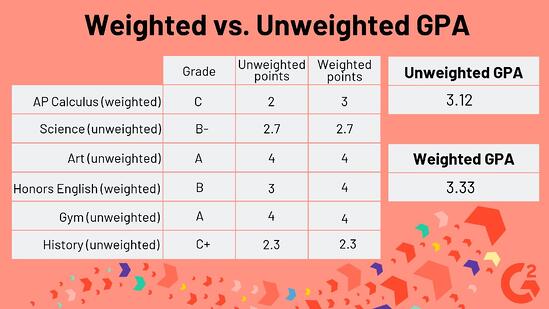Among many aspects upon college admission, Grade Point Average is regarded as one of the key aspects. Now, you can wonder what Grade Point Average (or GPA) means. It is a figure that shows your academic success on average. Generally, it is divided into two types – weighted and unweighted.
How do these two groups differ? The Weighted Grade Point Average applies the from-0-to-5.0 chart, plus it includes the course’s complexity and applicants’ academic success. As for the Unweighted Grade Point Average, it does not include the course’s complexity, and its highest scale point is 4.0.
Below, we’ll try to learn better these two Grade Point Average types.

The charts of Grade Point Average
As we’ve said before, Grade Point Average means the middle figure of all primary subjects’ scores. Grade Point Average has two types – unweighted and weighted. Below, we’ll leave you a small diagram of how both types look like:
Note – the letter means grade; the first number is Weighted (W) Grade Point Average; the second figure is Unweighted (U) type.
– A+ grade: 5.3 (Weighted), 4.3 (Unweighted)
– A grade: 5 (Weighted), 4 (Unweighted)
– A- grade: 4.7 (W), 3.7 (U)
– B+ grade: 4.3 (W), 3.3 (U)
– B grade: 4 (W), 3 (U)
– B- grade: 3.7 (W), 2.7 (U)
– C+ grade: 3.3 (W), 2.3 (U)
– C grade: 3 (W), 2 (U)
– C- grade: 2.7 (W), 1.7 (U)
– D+ grade: 2.3 (W), 1.3 (U)
– D grade: 2 (W), 1 (U)
– D- grade: 1.7 (W), 0.7 (U)
– F grade: 0 for both Weighted and Unweighted types

Now, let’s try to figure out in detail what Weighted Grade Point Average means.
The critical function of Weighted Grade Point Average is to evaluate the student’s potential of meeting the college challenges. This type of Grade Point Average includes two factors – the marks and the classes’ difficulty. The main message of the Weighted Grade Point Average is the following – there are classes harder than the other ones. That is why they are more weighted. The chart of Weighted Grade Point Average has the following figures – the lowest is 0, and the highest is 5.
Unweighted Grade Point Average is a more used method of academic record estimating in high school. Compared to the Weighted type, the Unweighted Grade Point Average does not include the difficulty level of the classes. As for the scale, its lowest point is 0, and the top is 4.
There is one question about Unweighted Grade Point Average that the experts have been discussing – should it be included when accepting the applicants? Later, we’ll speak about it.
How Grade Point Average types differ
As we’ve discussed before, the difference between Unweighted and Weighted types is the following – firstly, including the difficulty level of classes and the scale. But there is one more difference between them – The weighted type is estimated along with a program of Advanced Placement and awards. As for the Unweighted type, it is not included.
Now, we´ll together try to understand the procedure of estimating both Unweighted and Weighted Grade Point Average.
Let’s start with the Weighted Grade Point Average. It’s a little bit hard to estimate, but we’ll try.
When taking the class “AP,” we should add a 1.0 score. If taking classes with honors, we add 0.5 scores. As for the classes of introductory, we do not include any scores. To sum up, in the class of introductory A signifies 4.0, in classes of honor, it equals 4.5, and in classes of AP it means 5.
For example, you get 1 C, 3 As, and 1 B. We transcribe it the following way:
– C (classes of AP) means 3;
– A (classes of AP) equals 5;
– A (classes of honors) signifies 4.5;
– A (classes of introductory) means 4;
– B (classes of AP) equals 4, and B (classes of honors) means 3.5.
To know the Weighted Grade Point Average, you need to summarize the figures, and in total, you’ll have 24. Then you need to divide this number by the number of subjects (here, there are six), and after you get your weighted Grade Point Average – it is 4.
When it comes to the Unweighted type of Grade Point Average, we should note that it’s relatively simple to estimate than the Weighted type. Judge for yourself:
For instance, we have B that equals 3; D equals 1; A equals 4, and C equals 2.
Let’s imagine you get 1 C, 3 As, and 2 Bs. To know your Unweighted Grade Point Average, you need to multiply the amount of grade and its meaning and then summarize the figures:
(2*1) + (3*4) + (2*3) = in total, you’ll have 20.
After that, you need to divide this figure by the number of subjects. In your case, there are six. So, your Unweighted Grade Point Average is 3.33 (it’s a little bit higher than B grade).
There is one important note: This type of estimating is a very popular way of Weighted Grade Point Average estimating. The procedure of Weighted Grade Point Average estimating can range (it depends on the educational establishment).

Now, let’s find out what type of Grade Point Average the American educational establishments prefer more.
Of course, every educational establishment chooses its ways of estimating the applicants’ abilities. If we speak about what type of Grade Point Average they give preference more, a significant part opts for the Weighted type.
Depending on the school, Grade Point Average differs. There are educational establishments for whom the classes of Honors and AP are the highest level. For several schools, the highest level is classes of AP.
Besides, in some educational establishments, the classes of AP can be simpler than for others. For instance, if the student with the grade of A in AP mathematics gets the same points as the applicant with the grade of A in AP social science, it will not be fair. What does it mean? It means that the schools’ administrations review Grade Point Average depending on the context. All the schools offer their applicants the list of subjects, and the applicants need to choose what subjects they want to study.
One of the aspects that a significant part of colleges accounts for is the strictness of the students’ timetable. The American educational establishments do not demand the minimum APs number you should take at school or the lowest Grade Point Average they account for. When admitting, they look at other important aspects – academic success, timetable, personal and professional development.
Then, let’s see what policy of Grade Point Average the best educational establishments in the US follow:
– Harvard University considers two essential aspects when admitting the applicants – if the student has achieved the highest point of his personal academic capacity and what he does for his self-development. If you want to become a Harvard student, you need to have the highest Grade Point Average. But there are no requirements about what number it should be. For the University of Harvard, the love of learning and reaching the highest points are essential things.
– As for Stanford University, the critical aspect they consider when admitting students is their academic success. They do not have any demands of what Grade Point Average should be or the minimum test scores the students should have. What they value the most is students’ readiness to face the challenges and fight them.
– When it comes to Yale, this educational establishment does not practice estimating the Grade Point Average for the admitted applicants. They do not consider Grade Point Average at all. For them, the most important is to see that the applicants have chosen the most-ever-difficult program in their school and how they have managed to cope with it.
We do not doubt that you’ll worry about what a good Grade Point Average means. Depending on the chart, it can be different:
- Weighted Grade Point Average
– F grade – 0 (it’s the worst)
– D grade – 1
– C grade – 3 (it’s the middle figure)
– B grade – 4 (it’s rather good)
– A grade – 5 (it’s the highest top)
- Unweighted Grade Point Average type
– F grade – 0.0 (the lowest figure)
– D grade – 1.0
– C grade – 2.0 (the middle figure)
– B grade – 3.0 (it’s rather good)
– A grade – 4.0 (the highest figure)
With the Grade Point Average of 4, to what educational establishments can you go? You can go to: College of Harvard (with 4.18 Grade Point Average), University of Yale and Columbia University (both with 4.13), Technology Institute in California (4.21), Rice University (4.18), Institute of Technology in Massachusetts (4.17), etc.
To sum up
Grade Point Average is the middle figure of all main subjects’ points, and it is only one factor that the educational establishments consider when admitting students. They always go further than Grade Point Average. They want to have students who can face the challenges and reach the highest academic top.
